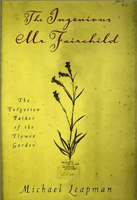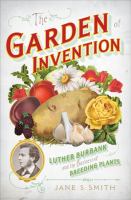If you’re looking for a new book to read, or desperate to find a gift for your garden loving friend, then take a look at these beauties!


The Ingenious Mr Fairchild by Michael Leapman
In the early 1700s the scientific world was coming to grips with the ‘shocking’ news that plants had male and female parts and reproduced sexually. Thomas Fairchild used this new understanding to create the first man-made hybrid in Europe: a cross between a carnation and a sweet william. It opened the door to hybridisation by man and caused quite a stir. Whether it was right to ‘play God’ and manipulate the natural order of things was a topic of serious concern in this age. It caused much of Fairchild’s work to be questioned, undervalued or simply overlooked for decades.
If you look around your garden now you might be surprised to discover that almost all your plants are hybrids. The results of man interferring with the sexual reproduction of plants to give us bigger flowers, new colours, better tasting fruit, disease resistance and other desirable traits. For putting us on this path we have the ingenious Mr Fairchild to thank.
The Garden of Invention by Jane S Smith
Luther Burbank is what The Garden of Invention is all about. Burbank was perhaps one of the most remarkable horticultural figures of the late 1800s and early 1900s. His keen eye, intuition and patience lead to the creation of over 800 new cultivars – both agricultural and ornamental. At a time where few people had the skills to breed a new plant Luther Burbank was churning them out by the bucket load. Could he make a white blackberry, a stoneless plum, a spineless cactus or a blight proof potato? Yes, yes, yes and yes! In fact his Burbank potato is still used by McDonalds for their fries today.
This ability to seemingly manufacture plants at will earned him legendary status and a cult following. Seems hard to believe in today’s age obsessed with pop stars and Hollywood actors that a horticulturist could attain such fame. However it was far from smooth sailing for Luther. Despite it being over 150 years after Thomas Fairchild’s work the scientific community was only just beginning to unlock the mechanics of genes and their role in hybridisation. They were still assessing what implications this could have on society. At the same time fortunes were to be made, and lost, through the introduction of new commercial crops. These external forces, along with Burbank’s internal desires, made for highs and lows throughout his long career.
These books make for interesting reading for all Plant Addicts. Both men pushed the boundaries of their eras, forcing the horticultural industry to open its eyes to new possibilities and challenging the societal norms of the day.
You’re unlikely to find either book in your regular bookstore so I’d recommend checking with Florilegium (my favourite gardening bookstore), Amazon or Abebooks.


PS Don’t forget to check out The Plant Addict Shop while you’re here.
You’ll find great gift ideas for garden lovers and fellow plant addicts!
